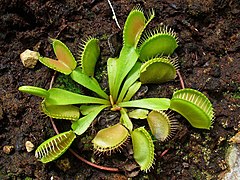 Hi everyone. I can tell the seasons are changing because I have a serious case of the "yuckies". So I am going to take a little break from presenting you with a good blog about nature. Instead I will give you a few facts about carnivorous plants. Most of us are familiar with Venus Flytraps, but there are many more. This will be a quick general lesson.
Hi everyone. I can tell the seasons are changing because I have a serious case of the "yuckies". So I am going to take a little break from presenting you with a good blog about nature. Instead I will give you a few facts about carnivorous plants. Most of us are familiar with Venus Flytraps, but there are many more. This will be a quick general lesson.The Venus flytrap consists of two lobes fastened to a central vein. When a creature lands on one of the lobes and tries to feed or get moisture from the plant... that is when the trouble begins. It touches the hairs on the inside of either lobe a couple of times and the lobes snap shut. A few days later the lobes will open with only the exoskeleton of the insect remaining.
Pitcher plants can be quite large. They are colorful and aromatic which lures the unsuspecting prey inside. Landing on the rim, a fly will lose its footing and fall down the long tubular leaf. Even if it tries to catch the side of the leaf, there are downward pointing hairs that impedes its being able to crawl back out. At the bottom of the tube is a sticky pool of digestive enzymes waiting to finish eating the fly. Some species of pitcher plant also have enzymes that stun the fly to keep it from too much struggling.
Butterworts are flowering carnivorous plants. Sometimes the edges of the leaves curl upward to prevent escape. An insect crawling on the forest floor climbs up onto the leaf of the butterwort looking for a drink. It quenches its thirst, tries to continue on its way and discovers that it cannot move. All it can do is sit and wait while it is being digested.
Bladderworts live under water. An insect that goes swimming quietly by doesn't feel any danger. It swims too close to the bladderwort and brushes against some hairs on the outer edge of the plant. Suddenly a trap door on the side of the plant flies open. Water rushes into the plant taking the insect along with it into a small sac inside. That is where digestion takes place. A bladderwort can take as little time as 1/30th of a second to capture its prey.
A thirsty butterfly sees a plant shiny with moisture and flies over to it. It lands on the plant and finds that it is stuck by the shiny, sticky liquid on the ends of each hair of the plant. This type of plant is a sundew. Once the butterfly is trapped by the sticky fluid, the hairs slowly bend inward taking the butterfly to where it will be digested.
Carnivorous plants eat insects in order to get the nutrients they provide. However they still use photosynthesis for the rest of their nutrition needs. None of these plants swallow their prey. The enzymes they secrete break down the soft tissues of the insect to make its nutrients ready to be absorbed into the plants.
Most carnivorous plants like acidic, boggy soils. As mentioned before, only bladderworts live in the water. Some of the carnivorous plants can be purchased for houseplants or gardens. They are especially fun for children to watch as they feed them. I did read that it is not advisable to feed them table food so follow directions that come with your plant.
I will return next week with a fascinating blog for you to visit. In the meantime, take time to visit one or more of our previous sites of the week. Then leave a nice comment and let them know Emma sent you.
Do you write a nature website or blog, or know of one, that you would like to introduce to our readers? Send me the information and I might feature it in one of my next reviews. Click here to find out how: Feature My Nature Site.
MMMM flies. I like to observe these plants and always am thrilled when botanical gardens have a few.
ReplyDeleteI love the Venus fly trap and have always found them fascination to watch. I did know about the other carnivorous plants too as I watched a documentary on them but seeing it written down like this brings home just what a gruesome death it is....yuck!!
ReplyDeleteI love a leave plant that closes at the touch of human. I don't know what it is called, but there are quite a few in Viet Nam. I bought a tiny one from Target (US) once, but it didn't live very long. I don't think they can be carnivorous to flies, but maybe to tiny little things.
ReplyDelete